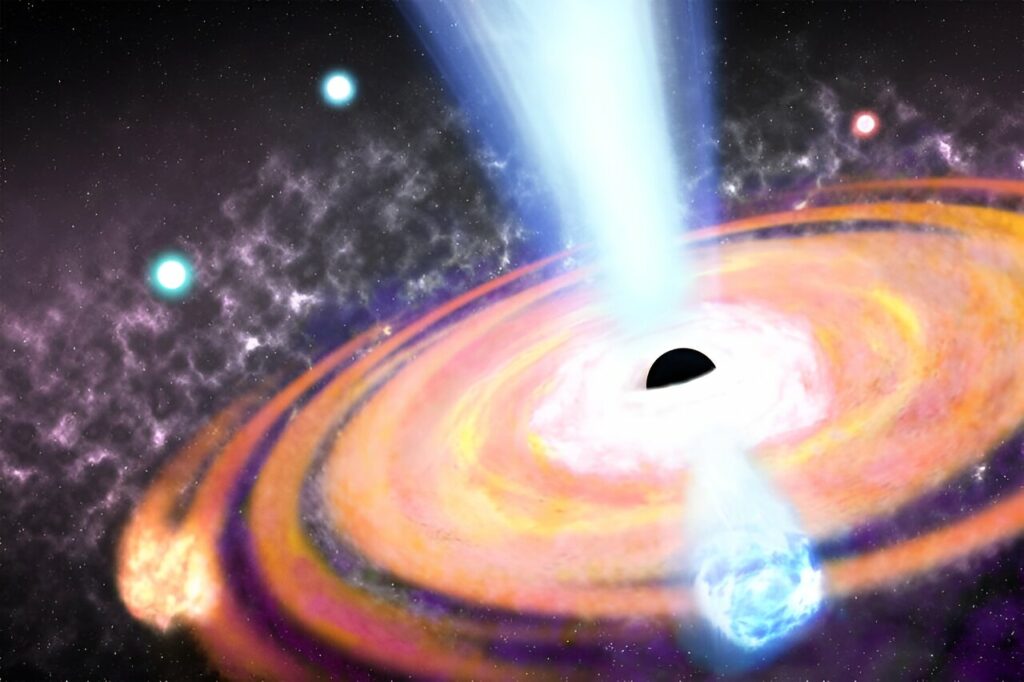Which predates the other: Black holes or galaxies?
According to a recent analysis of data from the James Webb Space Telescope, black holes not only existed at the beginning of the universe, but they also played a crucial role in the formation of new stars and galaxies. This discovery challenges the traditional understanding that black holes formed after the emergence of the first stars and galaxies. Instead, it suggests that black holes may have significantly accelerated the birth of new stars during the initial 50 million years of the universe’s existence. Lead author Joseph Silk, a professor at Johns Hopkins University and Sorbonne University, explains that these monster black holes were like building blocks or seeds for early galaxies, acting as powerful amplifiers of star formation. This finding has the potential to completely revolutionize our understanding of how galaxies are formed. The research has been published in the Astrophysical Journal Letters. When observing distant galaxies from the early universe through the Webb telescope, scientists were surprised to find that they appeared much brighter than expected and contained a higher number of young stars and supermassive black holes.

According to conventional wisdom, black holes were formed after the collapse of supermassive stars, while galaxies formed after the first stars illuminated the early universe. However, Silk’s team’s analysis suggests that black holes and galaxies coexisted and influenced each other’s destiny during the initial 100 million years. If we were to compare the entire history of the universe to a 12-month calendar, those years would be equivalent to the first days of January, as stated by Silk.
Silk argues that the outflows from black holes crushed gas clouds, transforming them into stars and significantly accelerating the rate of star formation. This phenomenon is crucial in understanding the origin of these bright galaxies, as they are typically smaller in the early universe. The question arises as to why they are producing stars at such a rapid pace.
Black holes are regions in space where gravity is incredibly strong, preventing anything, including light, from escaping their pull. Due to this immense force, they generate powerful magnetic fields that give rise to violent storms, expelling turbulent plasma and acting as colossal particle accelerators. Silk suggests that this process is likely the reason why Webb’s detectors have detected more black holes and bright galaxies than initially anticipated.
Although we cannot directly observe these violent winds or jets from distant locations, we know they must exist because we observe numerous black holes in the early universe. These tremendous winds originating from black holes crush nearby gas clouds, leading to the formation of stars. This missing link provides an explanation for why these initial galaxies are much brighter than expected.
Silk’s team has made predictions regarding the early stages of the universe, suggesting that it went through two distinct phases. In the first phase, black holes emitted high-speed outflows that accelerated the formation of stars. Then, in the second phase, these outflows slowed down. Around a few hundred million years after the big bang, gas clouds collapsed due to magnetic storms caused by supermassive black holes. This collapse led to the birth of new stars at a rate much higher than what is observed in normal galaxies billions of years later. However, as the powerful outflows transitioned into a state of energy conservation, the creation of stars gradually decreased. This was because the gas available for star formation in galaxies reduced.
Silk explained that the initial understanding was that galaxies formed when a massive gas cloud collapsed. However, the surprising discovery was that there was a seed within that cloud – a large black hole. This black hole played a crucial role in rapidly converting the inner part of the cloud into stars at a much higher rate than anticipated. As a result, the first galaxies appeared incredibly bright.
The team anticipates that future observations using the Webb telescope, which will provide more precise data on star and supermassive black hole counts in the early universe, will help validate their calculations. Silk believes that these observations will also contribute to unraveling more mysteries about the universe’s evolution.
The fundamental question remains: what were the origins of our universe? In the Milky Way galaxy alone, there are 100 billion stars, including our sun, and a massive black hole resides in its center. Silk wonders about the connection between these two entities. He expresses optimism that within a year, the availability of better data will bring us closer to finding answers to many of our questions.
This article is republished from PhysORG under a Creative Commons license. Read the original article.
Do not forget to share your opinion with us to provide you with the best posts !




0 Comments